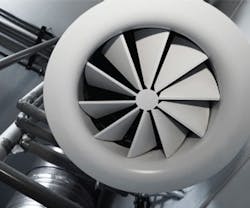Everyone knows the perks of green, sustainable buildings. While these buildings are inherently good, they also have associated risks from the "tight" construction of their envelopes.
Too Tight Causes Trouble
"The issue with tight building construction is that you may not get enough ventilation in the building," says Kent Peterson, PE with P2S Engineering, Inc. "Traditionally, buildings in the U.S. have had a fair amount of leakage designed into the buildings. The leakage actually makes up, in some cases, for a lack of ventilation rate." A tighter building means a more efficient building envelope, but if you don’t ensure that you’re maintaining the proper amount of outdoor ventilation for the people and the materials in the space, you can end up with "sick building syndrome."
"We’ve also seen a trend in the industry for mechanical systems," says Peterson. "Probably the most common system designed in larger buildings today is a variable air volume system. Traditionally, these systems have not had ventilation controls to ensure that you’re maintaining the proper amount of outdoor ventilation into the space as the load changes in the building. So on these systems, the fan reduces in air volume and there has to be adequate controls on the air handling unit to ensure that the outside air ventilation rate is not being reduced while the fan’s volume is being reduced."
Inadequate ventilation is commonly due to building design. "I run into buildings that weren’t designed properly," says Peterson. "They didn’t put in the controls to measure the outside air ventilation rates and the air handler was actually adjusting the fan cfm, and so as the fan cfm goes down, the outside air ventilation rate goes down, and you don’t get enough outside air ventilation."
Ventilation Virtues
Ventilation in buildings has two functions: one is to get odors out of the building, and the other is to flush (through dilution) the VOCs created by offgassing products – such as furniture – and building materials. Ventilation is not only a function of people in a space, but a function of both the number of people and the square footage component of the building type; even if you take all of the people out of a building, you still need to provide ventilation.
The distribution of air is just as important as the quantity of air passing through the building. "Building performance and building satisfaction is more a function of good air distribution than air volumes that go into a building," explains David Odom, vice president of Liberty Building Forensics Group. Quality air needs to be distributed in "the breathing zone" of the building. Building designers and contractors may design for a certain air volume, but they don’t know exactly how the air is distributed and where it goes. If the air takes a shortcut, it may never get into the breathing zone.
Sick Building Solution
ASHRAE Standard 62 addresses inadequate ventilation levels, from both tight construction and mechanical systems. However, that doesn’t necessarily mean that it’s standard practice in the industry and that everyone is caught up with the requirements. "It’s a requirement when you’re doing a LEED-certified building to ensure that you meet the ASHRAE Standard 62 requirements, so in that case you actually have someone who’s double-checking and making sure that all those controls are in place, and that you actually have adequate ventilation at all times in the building space."
If your building isn’t seeking LEED certification and you aren’t required to adhere to ASHRAE Standard 62, complying with the standard is one way to make sure your building is healthy and green – not green and sick.
"The solution is to ensure that you have adequate ventilation," says Peterson. "And the solution is to ensure that whatever we do for green building, we have requirements that are minimizing the amount of offgassing that comes from any of the building materials inside the building. If we can do source contaminate control and do control through furniture specifications, carpet specifications, and coating specifications – that makes for a much better indoor environment."
